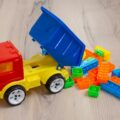Magnets for Toddlers
Looking for a fun and engaging way to bond with your toddler during playtime? Look no further than magnets for toddlers! These colorful and interactive toys are not only entertaining, but they also provide numerous educational benefits. In this article, I’ll share some exciting ideas on how you can make the most of your playtime with your child using magnets.
One of the great things about magnets for toddlers is their versatility. From building structures to creating artwork, the possibilities are endless. You can use magnetic blocks to teach your child about shapes and colors, or even introduce them to basic concepts like cause and effect as they discover how magnets attract and repel each other. By incorporating magnets into playtime, you can help stimulate your child’s imagination while promoting their cognitive development.
Choosing the Right Magnets for Toddlers
When it comes to playtime with your child, magnets can be a fantastic tool to enhance their learning and development. However, selecting the right magnets for toddlers is crucial to ensure both safety and educational value. Here are some key factors to consider when choosing magnets for your little one:
- Size and Shape: Opt for larger-sized magnets that are easy for tiny hands to grasp and manipulate. Avoid small or intricate shapes that could pose a choking hazard. Look for magnets with rounded edges to minimize the risk of injury.
- Material: Choose magnets made from durable and non-toxic materials such as high-quality plastic or wood. These materials not only withstand rough handling but also ensure the safety of your child during playtime.
- Magnetic Strength: Consider the magnetic strength of the magnets you choose. For toddlers, it’s best to go with low-strength magnets so they can easily separate them without struggling too much.
- Educational Value: Look for magnets that offer educational benefits by promoting cognitive skills, creativity, problem-solving, and sensory exploration. Magnets with letters, numbers, shapes, or animals can help introduce basic concepts while keeping your child engaged.
- Versatility: Opt for magnet sets that provide various options for play and learning activities. This way, you can keep your child entertained with different themes like farm animals, vehicles, or even building blocks.
Remember that adult supervision is always necessary during playtime with magnets to ensure their safe use and prevent any accidents or ingestion incidents.

Introducing Magnetic Play to Your Toddler
When it comes to playtime with your toddler, finding activities that are not only entertaining but also educational can be a challenge. That’s where magnets for toddlers come in! These versatile and engaging toys can provide countless hours of fun while promoting cognitive development and fine motor skills. So, let’s dive into the exciting world of magnetic play and discover how you can introduce it to your little one!
- Start with age-appropriate options: Before diving headfirst into magnetic play, make sure you choose toys that are suitable for your toddler’s age and developmental stage. Look for larger-sized magnets that are easy for their little hands to grasp and manipulate safely.
- Explore different types of magnets: Magnets come in various shapes, sizes, and materials. From classic fridge magnets to magnet tiles or even magnetized building blocks, there is a wide range of options available. Experiment with different types to see which ones capture your child’s interest the most.
- Create a magnetic play area: Designate a specific area in your home where your child can freely explore magnetic toys without any restrictions. A magnetic board or a metal baking sheet can serve as an excellent surface for them to arrange and rearrange the magnets as they please.
- Encourage open-ended play: Unlike some toys that have limited possibilities, magnets offer endless opportunities for creativity and imagination. Encourage your toddler to experiment by sticking different magnets together, creating patterns or shapes, or even using them in storytelling scenarios.
- Combine learning with play: Take advantage of the educational benefits of magnetic play by incorporating concepts like colors, shapes, numbers, or letters into the activity. Use alphabet magnets to spell out simple words or encourage counting using numbered magnet tiles.
Remember, safety should always be a priority when introducing any new toy to your child. Ensure that the magnets are securely attached and regularly inspect them for any signs of wear or damage. Supervise your child during playtime to prevent any accidental ingestion of small magnetic pieces.
Jessica has a flair for writing engaging blogs and articles. She enjoys reading and learning new things which enables her to write different topics and fields with ease. She also strives to break down complex concepts and make them easy for anybody to comprehend.





